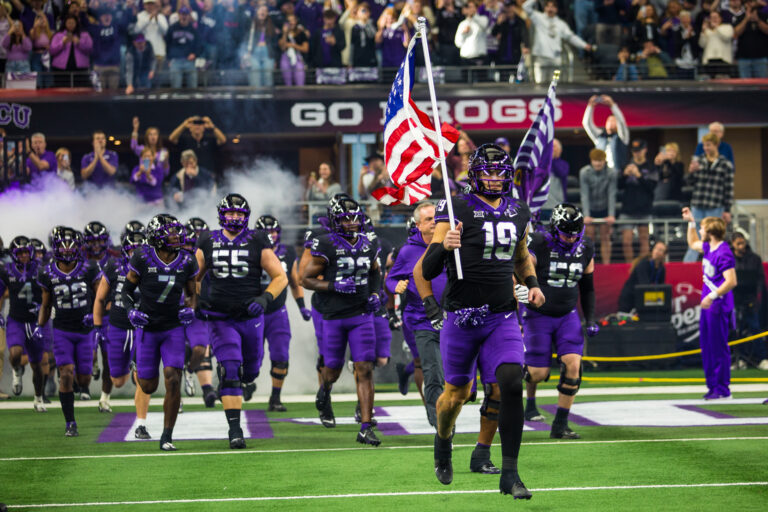
Elite athletes are special individuals with exceptional skill sets. Each athlete is from a different background and had access to different resources growing up. Most student-athletes have trained all their lives for this moment, but when the best of the best come together to compete in Division One Athletics, everyone starts fresh.
“It’s like being on the All-Star team in high school and now you are joining a team of All-Stars from all over the country, or even the world,” said David Gable, associate athletics director of sports medicine at TCU. “How student-athletes train and the effort and time they put into taking care of their body is what separates the average from the very good and the elite.”
The Human Performance Team is comprised of athletic trainers, strength and conditioning coaches, nutritionists, physical therapists, physicians, chiropractors, massage therapists and coaches, to name a few, all play a role in the success of a student-athlete and the team as a whole.
Harris College reached out to these sports medicine team members within TCU to share how they prep student-athletes for the football season, especially as the the team heads to the national championship.
Athletic Training
The Physical Exam
TCU wants all their student-athletes to start out healthy and ready for the physical and mental challenges ahead of them. Establishing a baseline and identifying past medical history is imperative as it helps determine any limitations and allows those issues to be addressed from the beginning. Associate Athletics Director of Sports Medicine, David Gable, explains what the student-athlete assessment entails:
- Body type
- Body composition
- Movement patterns
- Strength
- Level of conditioning
- Concussion testing
- Nutritional assessment
- Mental health assessment
- Academics assessment
Not everyone trains the same. A 300-pound lineman will not train the same way a 175-pound defensive back trains given the different skill sets involved. Because of this, strength and conditioning regimens are often position-specific.
Sharing the same goals and always keeping a student-athlete’s health and safety at the forefront is the number one priority. So, it is critical that the entire Human Performance Team shares information and communicates regularly.
Training and practice injuries are inevitable, but can be minimized by stressing the following:
- Getting adequate rest. Sleep gives the body time to recover and repair itself without stress.
- Hydration, hydration, hydration. Adequate fluid and electrolyte levels are important for everyone, especially active athletes. Fun Fact: Football student-athletes are required to carry a water bottle everywhere they go, all day long.
- Student-athletes have access to nutrition staff that can help them set goals and learn about different foods, cooking methods, weight maintenance, gain or loss, and how to make healthy choices. Nutrition counseling is always available. Nutrition is not just eating three meals a day; it is a lifestyle. To train well and reap the benefits, a student-athlete needs to give their body what it needs to perform well.
- Recover and replenish following a workout, practice or game. Recovery can mean a lot of things. Proper nutrition is part of recovery; rest is part of recovery; hydration is part of recovery; making good social and lifestyle choices is part of recovery and getting adequate rest is also part of recovery. Another part of recovery is treatment in the athletic training room. Warm and cold whirlpools, intermittent compression, cryotherapy including CryoSauna (nitrogen chamber), oxygen chambers, blood flow restriction devices and massage are considered part of the recovery process.
- Injury treatment. It is crucial in staying healthy or returning to baseline levels. Physicians, athletic trainers, physical and massage therapists, and chiropractors are all available to assist with injuries. There are numerous modalities that may be used to treat injuries when they occur and are based on the type of injury incurred and the athletes’ tolerance to these modalities. Examples of these are therapeutic exercise, dry needling, myofascial decompression, cupping, dynamic taping, electrical stimulation or ultrasound, laser therapy, pneumatic compression, pool therapy and oscillation therapy.
Helping Student-Athletes
Harris College discusses how Sports Psychology helps student-athletes understand themselves as student-athletes and how they respond in sports situations, and how Team Physicians help student-athletes keep not only their physical health but their mental health in check during football season, especially heading into the national championship.
Related Programs
Learn more about the programs within Harris College in these sports medicine and health fields:
Undergraduate programs:
- Movement Science
- Health & Fitness
- Physical Education with a Strength & Conditioning emphasis
Graduate programs:
- Athletic Training
- Kinesiology
- Social Work with Health and Mental Health emphases
For the programs that currently don’t exist, Harris College offers courses that provide students with foundational knowledge and research experience specific to these areas so they can successfully pursue graduate work in those professions.
Contributor: David Gable, MS, ATC, LAT, Associate Athletics Director of Sports Medicine and Ashlyne Elliott, PhD, LAT, ATC , Assistant Professor of Professional Practice in TCU Department of Kinesiology.